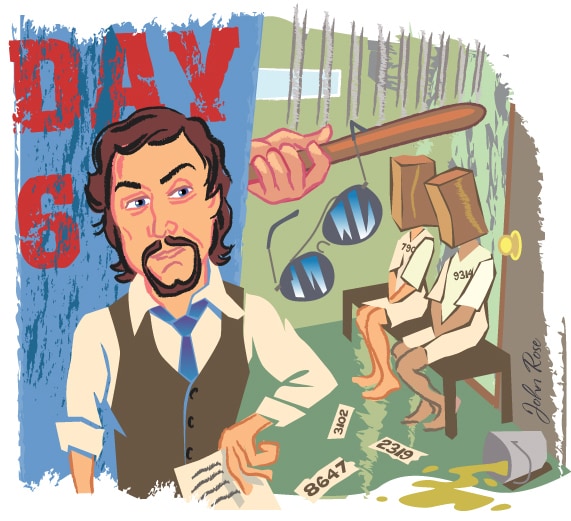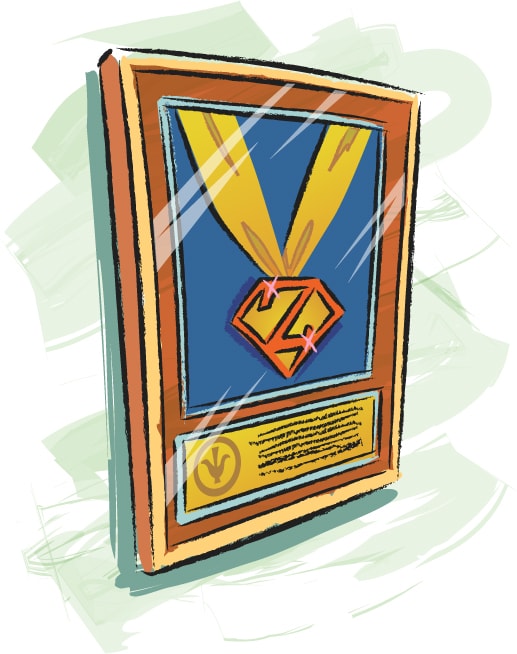
Who Is Philip Zimbardo?
Philip Zimbardo is a prominent Italian-American psychologist, author, and retired professor. He is best known for his work in the Stanford Prison Experiment—widely considered one of the most impactful and controversial social psychology experiments in history. The experiment has been the subject of conversations, classes, and even movies for years.
Philip Zimbardo Short Biography
Zimbardo was born in New York City in 1933. Zimbardo believes his interest in human behavior was sparked during his childhood. He often experienced prejudice and discrimination in those early years due to his Italian descent and poor financial background.
Despite his humble beginnings, Zimbardo completed his bachelor’s degree at Brooklyn College in 1954, with a triple major in psychology, sociology, and anthropology. He earned his Master’s degree (1955) and doctoral degree (1959) at Yale University. From 1959-2003, Zimbardo taught at a number of prestigious universities including Yale, New York University, Columbia, and Stanford.
What is The Stanford Prison Experiment?

The Stanford Prison Experiment was a study conducted in 1971 that examined how situational forces and perceived power affect human psychology. It focused primarily on the interactions and interpersonal relationships between prisoners and prison guards in a prison-like environment. The experiment was funded by the United States Office of Naval Research. The research team was led by Philip Zimbardo and included Craig Haney, W. Curtis Banks, and David Jaffe.
The experiment was conducted in the basement of the psychology building at Stanford University. After an ad was put out in the Palo Alto City newspaper, college students from all over the United States and Canada volunteered to participate. Those selected were assigned roles as either prisoners or prison guards. A mock prison with three small prison cells was constructed for the experiment.
As the study progressed, the relationship between the “prisoners” and the “prison guards” eroded drastically. Some reports suggest the prisoners were subjected to psychological torture. Several prisoners had to be released from the experiment when they were unable to cope with the deteriorating conditions. Although the study was designed to run for up to two weeks, it was brought to a premature end after just six days.
Stanford Prison Experiment Method
Twenty-four college males were recruited for the experiment. They were told the study involved a two-week prison simulation and they would be paid $15 per day. The subjects were primarily white, middle class, and had no criminal background. The researchers also took care to select participants who had no history of medical or psychological issues.
The subjects were randomly assigned as either prisoners or guards by flipping a coin. There were 9 guards (with 3 possible substitutes) and 9 prisoners (also with 3 possible substitutes). David Jaffe, who was an undergraduate research assistant at the time, served as the warden of the prison. Zimbardo played the role of superintendent.
The prison was intentionally constructed without windows or clocks. Each prison cell measured 6 x 9 feet, contained three cots, and held three prisoners. A long corridor (boarded up at each end) served as the "yard" for the prisoners. A small closet was used as the "hole" for solitary confinement.
The prisoners wore nylon stocking caps, a loose-fitting dress with an identification number, a heavy chain around their right ankle, rubber sandals, and no underclothes. Being forced to wear a dress immediately led to some prisoners having to sit more like a woman than a man. The prison attire was specially chosen to emasculate, humiliate, and oppress the inmates. The nylon caps symbolized their hair being shaved off and minimized their individuality.
Guards were given identical khaki uniforms, mirrored sunglasses to prevent eye-contact, a whistle, and a baton to symbolize their power. Their clothing gave them a sense of authority and anonymity. They were also given much more space than the prisoners as well as rest periods, personal comforts, and areas for relaxation. The guards received no formal training on prison management.
Rules of the Study
Before the study began, the guards were told not to harm the prisoners physically, or limit their food and water. However, they were allowed to induce fear or boredom in the prisoners, as well as take away their privacy. Rather than address the prisoners by name, the guards were instructed to call them by their identification numbers. Zimbardo designed the experiment to (1) give the guards the feeling of complete control and (2) rob the prisoners of their sense of reality, time, space, and self.
On the first day of the experiment, the Palo Alto police department assisted Zimbardo by arresting the prisoners at their homes and taking them through the entire booking process. The prisoners were charged with crimes, given their Miranda warning, handcuffed, fingerprinted, and photographed. The sudden, unexpected arrest left many of the prisoners in mild shock. After booking they were blindfolded and placed in a holding cell at the police station until pickup.
When the prisoners arrived at the mock prison they were strip searched and deloused. The purpose was to humiliate them and ensure no pests were introduced into the prison. Three guards worked at a time in eight hour shifts. The prisoners were forced to remain on site as they needed to be locked up for the majority of the experiment.
Results of the Stanford Prison Experiment
While the first day of the study ended without any major incident, the second day began with a riot. Some of the prisoners decided to block the cell doors with their beds. In a show of defiance, they discarded their caps and tore off their prison numbers. They also hurled insults at the guards.
With three guards finding it difficult to manage nine prisoners, the guards from the other shifts agreed to help end the riot. They eventually used a fire extinguisher to douse the prisoners in ice cold carbon dioxide and forced them away from the doors. Once inside the cells, the guards stripped the prisoners and took away their beds. The ringleaders were forced into solitary confinement.
Upon realizing that they were outnumbered on each shift, the guards decided to attack the prisoners psychologically in order to strengthen their control over them. Prisoners who did not actively participate in the revolt were placed in a “privilege cell” that offered clothing, better food, beds, and the opportunity to wash and brush their teeth. However, the prisoners in the privileged cell were soon replaced with prisoners who were in the "bad" cells. This tactic was used to confuse the prisoners and break their unity.
As a part of their psychological attack, the guards instructed the prisoners to memorize and repeat their assigned numbers throughout the day. This was usually done during the numerous prisoner counts. The guards also forced the prisoners to refer to each other by number. This tactic helped to deindividualize the prisoners and bolstered the idea that their numbers were their new identity.
Approximately 35 hours into the experiment, one prisoner—identified as #8612—began to scream, curse, and lash out in rage. The researchers were eventually forced to released him from the study as he showed signs of depression, disorganized thinking, and uncontrollable crying.
Increasing Cruelty
The researchers noted that as the experiment went on, the guards treated the prisoners with increasing cruelty. The guards developed a series of methods for punishing the prisoners which included:
- Doing tedious, meaningless work
- Refusing requests to go to the bathroom
- Not being allowed to empty their sanitation buckets (which were kept in the cells)
- Solitary confinement
- Sleep deprivation
- Cleaning toilets with their hands
- Cursing each other publicly
- Wearing a paper bag over their heads
- Laughing, singing or smiling on command
- Doing pushups, sometimes with a guard's foot on their backs
- Picking thorns out of their blankets (the blankets were dragged through thorn bushes by the guards)
All In on the Experiment
On day three, the guards became concerned after hearing a rumor that released prisoner #8612 planned to return with friends to break the other inmates out of prison. The researchers, who were now completely caught up in the experiment themselves, took steps to thwart the attack by moving the prison out of the basement to another floor. Zimbardo also planned to intercept the attackers and tell them that the study had ended. However, the attackers never showed up and the prison was moved back to the basement.
The longer the experiment went on, the more absorbed the participants and the researchers became. One guard who felt sorry for the prisoners and wanted to help them was encouraged by “warden” David Jaffe to get more involved and get tougher. By day five, three additional prisoners had to be released from the study because they showed signs of anxiety. A fifth inmate developed a psychosomatic rash over his entire body after his "parole" was rejected by a mock parole board. He too was released from the experiment.
Solitary Confinement
When prisoner #416—a newly admitted participant—refused to eat, he was subjected to increased abuse from the guards. When the guards were unable to force him to eat, #416 was put in solitary confinement. He was only allowed to return to his cell after seven of the other eight prisoners agreed to give up their blankets.
While the prisoners had shown solidarity during the first rebellion on day two, they now regarded #416 as just a trouble-maker. The unity among the inmates had completely deteriorated. In many cases they obeyed the guards blindly, even when the instructions were unjust. It appeared as if all the participants had forgotten that this was just an experiment.
Why Did the Stanford Prison Experiment End Early?
The study was brought to an abrupt end on day six. Christina Maslach—a graduate student in psychology and Zimbardo’s girlfriend at the time—arrived on site to conduct a series of interviews with the subjects. When she saw the condition the prisoners were in, her immediate reaction was one of shock and disgust. The Stanford Prison Experiment was discontinued later that day after Maslach strongly questioned the morality of the study.
Conclusions from the Stanford Prison Experiment
The study highlighted how certain social contexts can significantly influence or transform human behavior. Although all the subjects had been carefully screened across a variety of physical and personality measures before the study, it did not take long for them to act in a manner neither they nor the researchers expected. Some guards became increasingly cruel and sadistic in their efforts to harass the prisoners. The other guards gave off an air of indifference and did nothing to stop the mistreatment.
The prisoners also showed drastic changes in behavior due to the psychological trauma they experienced. Some inmates begged to be released from prison shortly after the experiment started and most of them were willing to obey even the most unreasonable commands from the guards. Zimbardo believed that the participants’ change in behavior was because they had begun to internalize their assigned roles. As the experiment went on, the guards increasingly believed they had the authority to do anything they wanted within the confines of the prison and the prisoners increasingly thought of themselves as less than important than the guards.
The goal of the Stanford Prison Experiment was to show how prison-like environments could influence the people who pass through them. It clearly demonstrated how insane situations can lead to insane behaviors from normal people. It also highlighted the power of perceived authority, the pressure individuals face to conform to their assigned social group, and how people may respond to cognitive dissonance.
The researchers believed the behavior of the students greatly mirrored the behavioral patterns found in actual prisons. Several insights from the experiment were adopted by the United States government to improve the management of correctional facilities across the nation.
Criticism and Limitations of The Stanford Prison Experiment
Over the years, an increasing number of people have expressed concerns about the ethics of the Stanford Prison Experiment. Many critics were appalled that young men were subjected to psychological torture for days in the name of social psychology. The extremely unsanitary condition of the mock prison also raised concerns about the physical health of the inmates. The fact that the guards were able to find ways to harass the prisoners without being supervised by the research team was another safety issue that was not adequately addressed before or during the study.
Several critics argued that the experiment lacked scientific rigor and produced no real results. They believe the behavior of the students was influenced by the fact that they knew they were being observed. Rather than a behavioral change occurring naturally, some opponents point to the fact that Zimbardo explicitly instructed the guards to use psychological tactics. After the study, one guard commented that he behaved the way he did because he wanted the researchers to get good data they could work with.
Later reports even show that the guards were instructed to "act tough."
Zimbardo himself admitted that the study did not measure up to the standards of a scientific experiment as it did not have a control group, a comparison group, or other defined variables. Rather than a rigorous scientific experiment, Zimbardo asserted that his study was a valid demonstration of what can happen to human behavior in certain social contexts.
Replications of Stanford Prison Experiment
A number of researchers have tried to replicate the Stanford Prison Experiment in the decades that followed. But although they copied Zimbardo’s methodology, they were not able to replicate his findings. However, real-world events at Abu Ghraib prison brought the Stanford Prison Experiment back to public attention in 2004. The sadistic acts committed by several United States military personnel at the Iraqi prison almost perfectly mirrored Zimbardo's 1971 study.
Zimbardo’s Other Interests, Contributions, and Awards

After the Stanford Prison Experiment, Zimbardo delved into other areas of social psychology that interested him. This included in-depth research on topics such as the psychology of shyness, evil, violence, terrorism, heroism, madness, persuasion, hypnosis, dissonance, and time perspective. He has written several books on his findings and some of his research papers are considered required reading for a number of psychology courses today. In 2012, he was awarded the American Psychological Foundation Gold Medal for Lifetime Achievement in the Science of Psychology.
References
Haney, C. & Zimbardo, P. (1998). The past and future of u.s. prison policy: Twenty-five years after the stanford prison experiment. American Psychologist, 53 (7), 709-727. Retrieved from https://www.gvsu.edu/cms4/asset/F51281F0-00AF-E25A-5BF632E8D4A243C7/stanford_prison_experiment.pdf
O’Toole, K. (1997, January 8). The stanford prison experiment: Still powerful after all these years. Retrieved from https://news.stanford.edu/pr/97/970108prisonexp.html
Philip. G. Zimbardo. (2016, September 8). Retrieved from http://zimbardo.socialpsychology.org/
The Story: An Overview of the Experiment. (n.d.). Retrieved from https://www.prisonexp.org/
Zimbardo, P., Haney, C., Banks, W. C. & Jaffe, D. (1971). The stanford prison experiment: A simulation study of the psychology of imprisonment. Retrieved from https://web.stanford.edu/dept/spec_coll/uarch/exhibits/Narration.pdf
